Analysis and Prediction of Spatial and Temporal Evolution of Ecosystem Service Value on the Northern Slopes of the Kunlun Mountains Based on Land Use
Abstract
:1. Introduction
2. Data and Materials
2.1. Study Area
2.2. Data Sources
2.3. Single Land-Use Dynamic Attitude
2.4. Calculation of the Value of Ecosystem Services
2.5. Ecosystem Service Change Index
2.6. Spatial Autocorrelation Analysis
2.7. CA–Markov Model
3. Results and Analysis
3.1. Spatial and Temporal Variation Characteristics of Land-Use Types
3.2. Spatial and Temporal Variation Characteristics of ESV
3.2.1. Characteristics of Changes in the Temporal Dimension of ESV
3.2.2. Characteristics of Changes in ESV Spatial Dimension
3.3. Spatial Correlation Analysis of ESV
3.3.1. Spatial Autocorrelation Analysis
3.3.2. Cold Hot Spot Analysis
3.4. CA–Markov Model Simulation and Prediction
4. Discussion
4.1. Methods for Valuing Ecosystem Services
4.2. Impacts of Land Use on the Value of Ecosystem Services
4.3. Ecological Conservation and Development in the Study Area
5. Conclusions
- (1)
- Unexploited land, grassland, and watershed are the land-use types that account for more than 85% of the study area. During the study period, the water area showed a continuous growth trend, while grassland, cropland, woodland, and construction land showed a fluctuating growth trend and barren land charted a continuous decline. Among these land types, construction land had the highest increase (291.04%), followed by woodland, whereas grassland had the lowest increase. Only barren land showed a decrease.
- (2)
- The ESV of the study area trended slightly downward from 1990 to 2000 and sharply upward from 2000 to 2010, and then reverted to a slight downward trend from 2010 to 2020. The overall ESV showed an upward trend from 1990 to 2020, with a total increase of CNY 17.906 billion. The upward trend of watershed areas intensified the most from 2000 to 2010, with ESV increasing by CNY 39.857 billion due mainly to low-value land-use types shifting to high-value land-use types.
- (3)
- In terms of space, the value-added areas of ESV in the study area from 1990 to 2020 are mainly concentrated in the northwest and southern regions of the study area. the loss area of ESV is mainly distributed in the northern part of the study area. Based on the cold and hot spot map of ESV changes in the study area, it can be seen that the ecosystem service value of the northern slopes of the Kunlun Mountains is increasing. According to the CA–Markov model analysis, the grassland, forest land, and water area in the study area will increase from 2020 to 2030. The growth trend of the ecosystem service value of the northern slopes of the Kunlun Mountains is obvious in 2030, and the ecological environment will steadily improve. This is due to the conversion of unused land into grassland and forest land. We also found that the conversion of unused land into grassland has a positive impact on the ecology of the region. In the future, we will continue to research the northern slopes of the Kunlun Mountains, explore the driving factors of ecosystem service value, and conduct in-depth research on the impact of climate change on the ecosystem service value of the northern slopes of the Kunlun Mountains.
Author Contributions
Funding
Data Availability Statement
Conflicts of Interest
References
- Costanza, R.; D’Arge, R.; Groot, R.D.; Farber, S.; Grasso, M.; Hannon, B.; Limburg, K.; Naeem, S.; Neill, R.V.; Paruelo, J.; et al. The value of the world’s ecosystem services and natural capital. Nature 1997, 387, 253–260. [Google Scholar] [CrossRef]
- Darvill, R.; Lindo, Z. The inclusion of stakeholders and cultural ecosystem services in land management trade-off decisions using an ecosystem services approach. Landsc. Ecol. 2016, 31, 533–545. [Google Scholar] [CrossRef]
- Daily, G.C. Nature’s Services: Societal Dependence on Natural Ecosystems; Island Press: Washington, DC, USA, 1997; p. 3. [Google Scholar]
- OuYang, Z.Y.; Wang, X.K.; Miao, H. A preliminary study on the service functions of terrestrial ecosystems and their ecological and economic values in China. J. J. Ecol. 1999, 5, 19–25. [Google Scholar]
- Xie, G.D.; Zhang, C.X.; Zhang, C.S.; Xiao, Y.; Lu, C.X. The value of ecosystem services in China. Resour. Sci. 2005, 37, 1740–1746. [Google Scholar]
- Parron, L.M.; Villanueva, A.J.; Glenk, K. Estimating the value of ecosystem services in agricultural landscapes amid intensification pressures: The Brazilian case. Ecosyst. Serv. 2022, 57, 101476. [Google Scholar] [CrossRef]
- Shi, F.; Zhou, B.; Zhou, H.; Zhang, H.; Li, H.; Li, R.; Guo, Z.; Gao, X. Spatial Autocorrelation Analysis of Land Use and Ecosystem Service Value in the Huangshui River Basin at the Grid Scale. Plants 2022, 11, 2294. [Google Scholar] [CrossRef]
- Braun, D.; de Jong, R.; Schaepman, M.E.; Furrer, R.; Hein, L.; Kienast, F.; Damm, A. Ecosystem service change caused by climatological and non-climatological drivers: A Swiss case study. Ecol. Appl. A Publ. Ecol. Soc. Am. 2019, 29, e01901. [Google Scholar] [CrossRef]
- Pan, N.; Guan, Q.; Wang, Q.; Sun, Y.; Li, H.; Ma, Y. Spatial differentiation and driving mechanisms in ecosystem service value of arid region:a case study in the middle and lower reaches of shule river basin, nw china. J. Clean. Prod. 2021, 319, 128718. [Google Scholar] [CrossRef]
- Nelson, E.; Mendoza, G.; Regetz, J.; Polasky, S.; Tallis, H.; Cameron, D.R.; Chan, K.M.A.; Daily, G.C.; Goldstein, J.; Kareiva, P.M. Modeling multiple ecosystem services, biodiversity conservation, commodity production, and tradeoffs at landscape scales. Front. Ecol. Environ. 2009, 7, 4–11. [Google Scholar] [CrossRef]
- Felipe-lucia, M.R.; Comín, F.A.; Bennett, E.M. Interactions among ecosystem services across land uses in a floodplain agroecosystem. Ecol. Soc. 2014, 19, 360–375. [Google Scholar] [CrossRef]
- Gren, I.M.; Groth, K.H.; Sylvén, M. Economic values of danube floodplains. J. Environ. Manag. 1995, 45, 333–345. [Google Scholar] [CrossRef]
- Benez, S.; Fabio, J.D.; Puneet, F.; Susana, H.C.; Jeffrey, W. Trade-offs Between the Value of Ecosystem Services and Connectivity Among Protected Areas in the Upper Chattahoochee Watershed. J. Environ. Manag. 2022, 69, 937–951. [Google Scholar]
- Wu, C.Y.; Chen, B.; Huang, X.J.; Wei, Y.H.D. Effect of land-use change and optimization on the ecosystem service values of Jiangsu province, China. J. Ecol. Indic. 2020, 117, 106507. [Google Scholar] [CrossRef]
- Gagarin, L.; Wu, Q.; Cao, W. Icings of the Kunlun Mountains on the Northern Margin of the Qinghai-Tibet Plateau, Western China: Origins, Hydrology and Distribution. J. Water 2022, 14, 2396. [Google Scholar] [CrossRef]
- Kang, L.; Jia, Y.; Zhang, S.L. Spatiotemporal distribution and driving forces of ecological service value in the Chinese section of the “Silk Road Economic Belt”. J. Ecol. Indic. 2022, 141, 109074. [Google Scholar] [CrossRef]
- Ma, X.; Zhang, H. Land-Use/Land-Cover Change and Ecosystem Service Provision in Qinghai Province, China: From the Perspective of Five Ecological Function Zones. J. Land. 2023, 12, 656. [Google Scholar] [CrossRef]
- Chen, Y.; Xu, E. The Spatiotemporal Change in Land Cover and Discrepancies within Different Countries on the Qinghai–Tibet Plateau over a Recent 30-Year Period. Land 2023, 12, 1797. [Google Scholar] [CrossRef]
- Hughes-Allen, L.; Bouchard, F.; Séjourné, A.; Fougeron, G.; Léger, E. Automated Identification of Thermokarst Lakes Using Machine Learning in the Ice-Rich Permafrost Landscape of Central Yakutia (Eastern Siberia). Remote Sens. 2023, 15, 1226. [Google Scholar] [CrossRef]
- Mantas, V.; Caro, C. User-Relevant Land Cover Products for Informed Decision-Making in the Complex Terrain of the Peruvian Andes. Remote Sens. 2023, 15, 3303. [Google Scholar] [CrossRef]
- Druckenmiller, H. Accounting for ecosystem service values in climate policy. J. Nat. Clim. Chang. 2022, 12, 596–598. [Google Scholar] [CrossRef]
- Maimaiti, B.; Chen, S.; Kasimu, A. Coupling and Coordination Relationships between Urban Expansion and Ecosystem Service Value in Kashgar City. Remote Sens. J. 2022, 14, 2557. [Google Scholar] [CrossRef]
- Niu, S.; Sun, M.; Wang, G.; Wang, W.; Yao, X.; Zhang, C. Glacier Change and Its Influencing Factors in the Northern Part of the Kunlun Mountains. Remote Sens. 2023, 15, 3986. [Google Scholar] [CrossRef]
- Zhang, Z.; Xia, F.; Yang, D.; Huo, J.; Chen, H. Spatiotemporal characteristics in ecosystem service value and its interaction with human activities in Xinjiang, China. J. Ecol. Indic. 2020, 110, 105826. [Google Scholar] [CrossRef]
- Beaudon, E.; Sheets, J.M.; Martin, E.; Sierra-Hernández, M.R.; Mosley-Thompson, E.; Thompson, L.G. Aeolian Dust Preserved in the Guliya Ice Cap (Northwestern Tibet): A Promising Paleo-Environmental Messenger. Geosciences 2022, 12, 366. [Google Scholar] [CrossRef]
- Zhu, S.; Zhao, Y.; Huang, J.; Wang, S. Analysis of Spatial-Temporal Differentiation and Influencing Factors of Ecosystem Services in Resource-Based Cities in Semiarid Regions. J. Remote Sens. 2023, 15, 871. [Google Scholar] [CrossRef]
- Ma, X.; Yan, W.; Zhao, C.; Kundzewicz, Z.W. Snow-Cover Area and Runoff Variation under Climate Change in the West Kunlun Mountains. Water 2019, 11, 2246. [Google Scholar] [CrossRef]
- Li, C.G.; Wang, M.; Liu, W.; Lee, S.Y.; Hou, J. Quantitative estimates of Holocene glacier meltwater variations on the Western Tibetan Plateau. J. Earth Planet. Sci. Lett. 2021, 559, 116766. [Google Scholar] [CrossRef]
- Lu, Q.; Hua, D.; Li, Y.; Wang, D. Estimation of Water Resource Ecosystem Service Value inTarim River Basin—From a Full Value Chain Perspective. Water 2022, 14, 2355. [Google Scholar] [CrossRef]
- Xu, H.; Yang, J.; Xia, G.; Lin, T. Spatio-temporal Differentiation of Coupling Coordination between Ecological Footprint and Ecosystem Service Functions in the Aksu Region, Xinjiang, China. Sustainability 2022, 14, 3483. [Google Scholar] [CrossRef]
- Adila, A.; Abudukeyimu, A.; Abdugheni, A.; Abdulla, A.; Jiao, J.; Bin, O. Land Use and Land Cover Change Effects on the Value of Ecosystem Services in the Konqi River Basin, China, under Ecological Water Conveyance Conditions. Forests 2023, 14, 1028. [Google Scholar]
- Yang, J.; Huang, X. The 30 m annual land cover dataset and its dynamics in China from1990 to 2019. J. Earth Syst. Sci. Data 2021, 13, 3907–3925. [Google Scholar] [CrossRef]
- Liu, C.; Xu, R.; Xu, K.; Lin, Y.; Cao, Y. Carbon Emission Effects of Land Use in Chaobai River Region of Beijing–Tianjin–Hebei, China. Land 2023, 12, 1168. [Google Scholar] [CrossRef]
- Xie, G.D.; Zhang, C.X.; Zhen, L.M.; Chen, W.H.; Li, S.M. Dynamic changes in the value of China’s ecosystem services—ScienceDirect. J. Ecosyst. Serv. 2017, 26, 146–154. [Google Scholar] [CrossRef]
- Zhang, S.; Wang, Y.; Wang, Y.; Li, Z.; Hou, Y. Spatiotemporal Evolution and Influencing Mechanisms of Ecosystem Service Value in the Tarim River Basin, Northwest China. Remote Sens. 2023, 15, 591. [Google Scholar] [CrossRef]
- Ling, H.B.; Yan, J.J.; Xu, H.L.; Guo, B.; Zhang, Q.Q. Estimates of shifts in ecosystem service values due to changes in key factors in the Manas River basin, northwest China. J. Sci. Total Environ. 2019, 659, 177–187. [Google Scholar] [CrossRef]
- Orna, R.; Shiri, Z.; Ido Izhaki, A.L. The effect of wildfire and land-cover changes on the economic value of ecosystem services in Mount Carmel Biosphere Reserve, Israel. J. Ecosyst. Serv. 2021, 49, 101291. [Google Scholar]
- Wan, L.H.; Wang, S.W.; Chen, X.H. Spatial correlation of GDP in Hadazhi industrial corridor based on GeoDA. Geogr. Res. 2011, 30, 8. [Google Scholar]
- Wu, X.; Zhang, L.; Gao, L.; Li, Y.; Liu, X. Change and Tradeoff/Synergy Analysis of Watershed Ecosystem Services: A Case Study of Qinghai Lake Basin. Sustainability 2023, 15, 11711. [Google Scholar] [CrossRef]
- Guo, C.Y.; Gao, S.; Zhou, B.Y.; Gao, J.H. Effects of land use change on ecosystem service value in Funiu Mountain based upon a grid square. J. Acta Ecol. Sin. 2019, 39, 3482–3493. [Google Scholar]
- Di-Gregaria, A.; Jonsen, L.J. Land Cover Classification System, Concepts and User Manual; FAO: Rome, Italy, 2005. [Google Scholar]
- Bcp, A.; Dgb, B.; Bas, C.; Gam, D. Using neural networks and GIS to forecast land use changes: A Land Transformation Model. Computers. Environ. Urban Syst. 2002, 26, 553–575. [Google Scholar]
- Ouyang, Z.; Zheng, H.; Xiao, Y.; Polasky, S.; Liu, J.; Xu, W.; Wang, Q.; Zhang, L.; Xiao, Y.; Rao, E.; et al. Improvements in ecosystem services from investments in natural capital. J. Sci. 2016, 352, 1455–1459. [Google Scholar] [CrossRef]
- Long, X.R.; Lin, H.; An, X.X.; Chen, S.D.; Qi, S.Y.; Zhang, M. Evaluation and analysis of ecosystem service value based on land use/cover change in Dongting Lake wetland. J. Ecol. Indic. 2022, 136, 108619. [Google Scholar] [CrossRef]
- Li, C.; Zheng, H.; Li, S.Z.; Chen, X.S.; Li, J.; Zeng, W.H.; Liang, Y.C.; Polasky, S.; Feldman, M.W.; Ruckelshaus, M.; et al. Impacts of conservation and human development policy across stakeholders and scales. Proc. Natl. Acad. Sci. USA 2015, 112, 7396–7401. [Google Scholar] [CrossRef]
- Cheng, Q.; Zhou, L.; Wang, T. Assessment of ecosystem services value in Linghekou wetland based on landscape change. Environ. Sustain. Indic. 2022, 15, 100195. [Google Scholar] [CrossRef]
- Xiao, Y.; Huang, M.D.; Xie, G.D.; Zhen, L. Evaluating the impacts of land use change on ecosystem service values under multiple scenarios in the Hunshandake region of China. J. Sci. Total Environ. 2022, 850, 158067. [Google Scholar] [CrossRef]
- Belay, T.; Melese, T.; Senamaw, A. Impacts of land use and land cover change on ecosystem service values in the Afroalpine area of Guna Mountain, Northwest Ethiopia. Heliyon 2022, 8, e12246. [Google Scholar] [CrossRef]
- Hoque, M.Z.; Islam, I.; Ahmed, M.; Hasan, S.S.; Prodhan, F.A. Spatio-temporal changes of land use land cover and ecosystem service values in coastal Bangladesh. Egypt. J. Remote Sens. Space Sci. 2022, 25, 173–180. [Google Scholar]
- DeLoyde, C.N.M.; Mabee, W.E. Ecosystem service values as an ecological indicator for land management decisions: A case study in southern Ontario, Canada. Ecol. Indic. 2023, 151, 110344. [Google Scholar] [CrossRef]
- Hang, X.; Chen, D.C.; Fan, J.D.; Yu, C.; Zhou, Y.; Tang, J.J. Study on the change of ecosystem service value and its correlation with human activities: Taking Changzhou City as an example. J. Environ. Eng. Technol. 2022, 12, 2124–2131. [Google Scholar]
- Liu, W.; Liu, Z.; An, Z. Late Miocene episodic lakes in the arid Tarim Basin, western China. Proc. Natl. Acad. Sci. USA 2014, 111, 16292–16296. [Google Scholar] [CrossRef] [PubMed]
- María, R.F.L.; Soliveres, S.; Penone, C. Land-use intensity alters networks between biodiversity, ecosystem functions, and services. Proc. Natl. Acad. Sci. USA 2020, 117, 28140–28149. [Google Scholar]
- Gui, D.; Lei, J.; Mu, G.; Zeng, F. Effects of different management intensities on soil quality of farmland during oasis development in southern Tarim Basin, Xinjiang, China. J. Int. J. Sustain. Dev. World Ecol. 2009, 16, 295–301. [Google Scholar] [CrossRef]
- Xie, L.; Wang, H.W.; Liu, S.H. The ecosystem service values simulation and driving force analysis based on land use/land cover: A case study in inland rivers in arid areas of the Aksu River Basin, China. J. Ecol. Indic. 2022, 138, 108828. [Google Scholar] [CrossRef]
- Ling, H.B.; Guo, B.; Zhang, G.P.; Xu, H.L.; Deng, X.Y. Evaluation of the ecological protective effect of the “large basin” comprehensive management system in the Tarim River basin, China. Sci. Total Environ. 2019, 650, 1696–1706. [Google Scholar] [CrossRef]
- Wang, Y.; Shataer, R.; Zhang, Z.C.; Zhen, H.; Xia, T. Evaluation and Analysis of Influencing Factors of Ecosystem Service Value Change in Xinjiang under Different Land Use Types. J. Water 2022, 14, 1424. [Google Scholar] [CrossRef]
- Kulaixi, Z.; Chen, Y.; Li, Y.; Wang, C. Dynamic Evolution and Scenario Simulation of Ecosystem Services under the Impact of Land-Use Change in an Arid Inland River Basin in Xinjiang, China. J. Remote Sens. 2023, 15, 2476. [Google Scholar] [CrossRef]
- Yu, X.; Xiao, J.; Huang, K.; Li, Y.; Lin, Y.; Qi, G.; Liu, T.; Ren, P. Simulation of Land Use Based on Multiple Models in the Western Sichuan Plateau. Remote Sens. 2023, 15, 3629. [Google Scholar] [CrossRef]
- Amir Siddique, M.; Wang, Y.; Xu, N.; Ullah, N.; Zeng, P. The Spatiotemporal Implications of Urbanization for Urban Heat Islands in Beijing: A Predictive Approach Based on CA–Markov Modeling (2004–2050). Remote Sens. 2021, 13, 4697. [Google Scholar] [CrossRef]
- Huang, X.; Ma, J.L. Changes in the ecosystem service values of typical river basins in arid regions of Northwest China. J. Ecohydrol. 2013, 6, 1048–1056. [Google Scholar] [CrossRef]

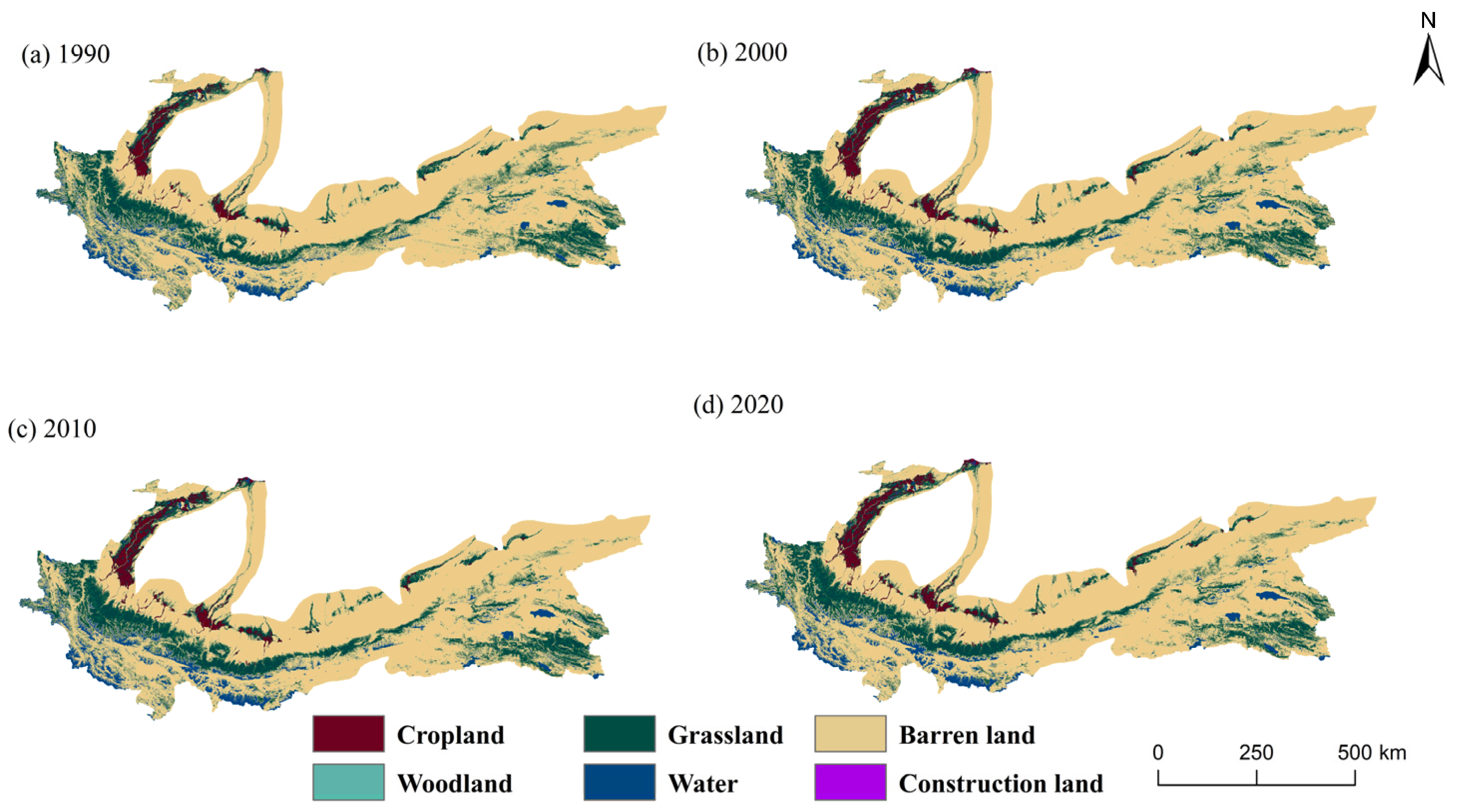
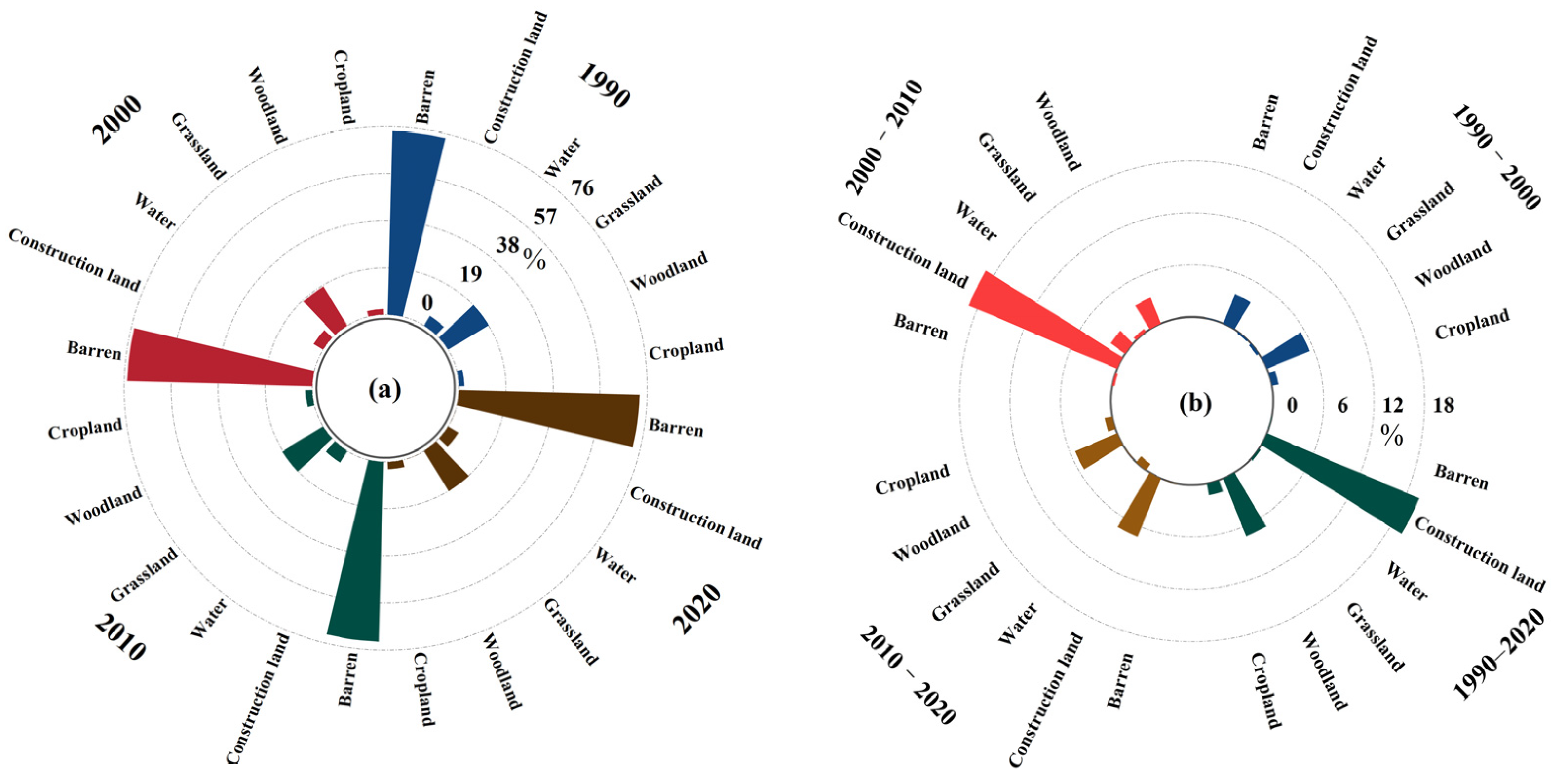

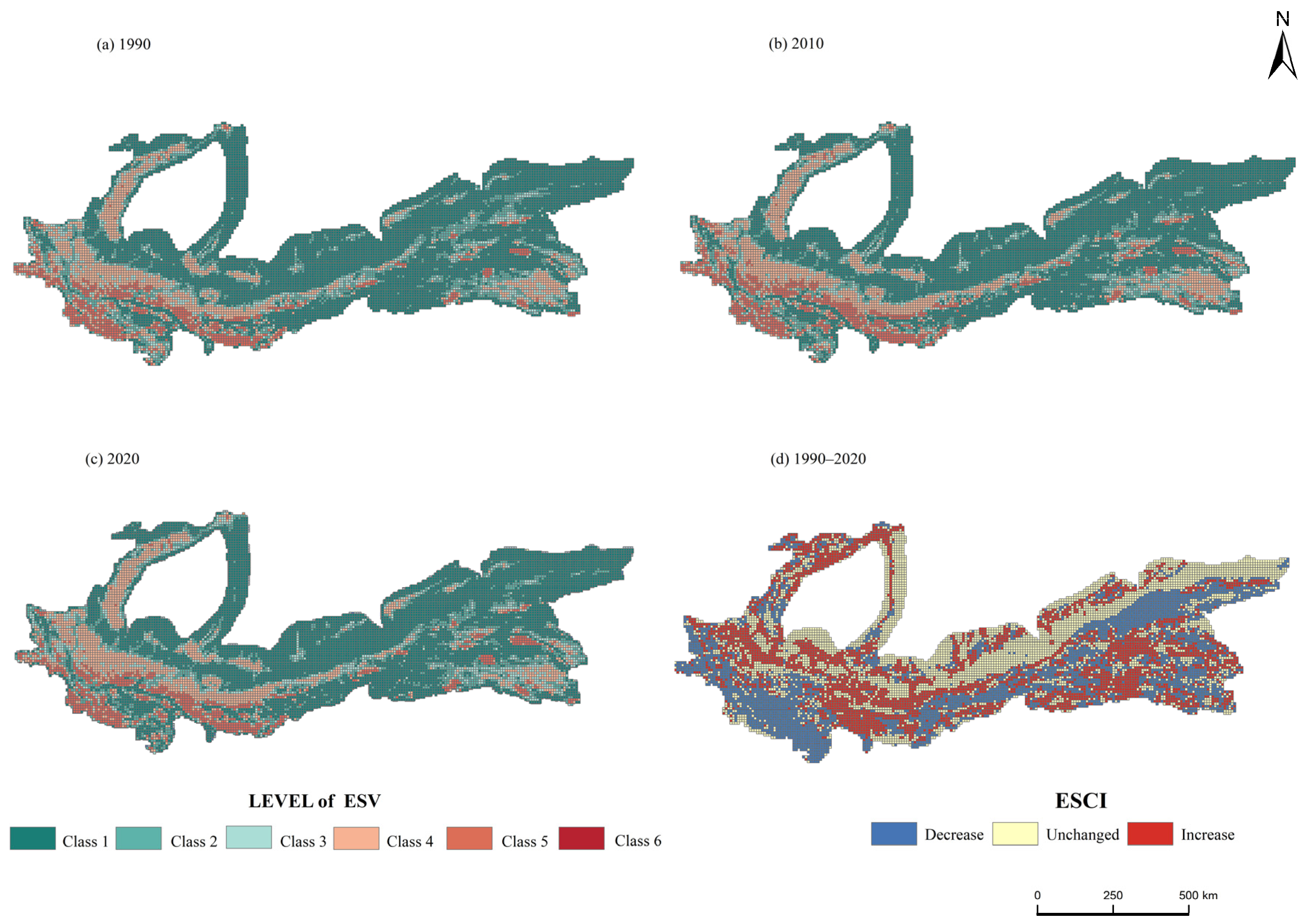
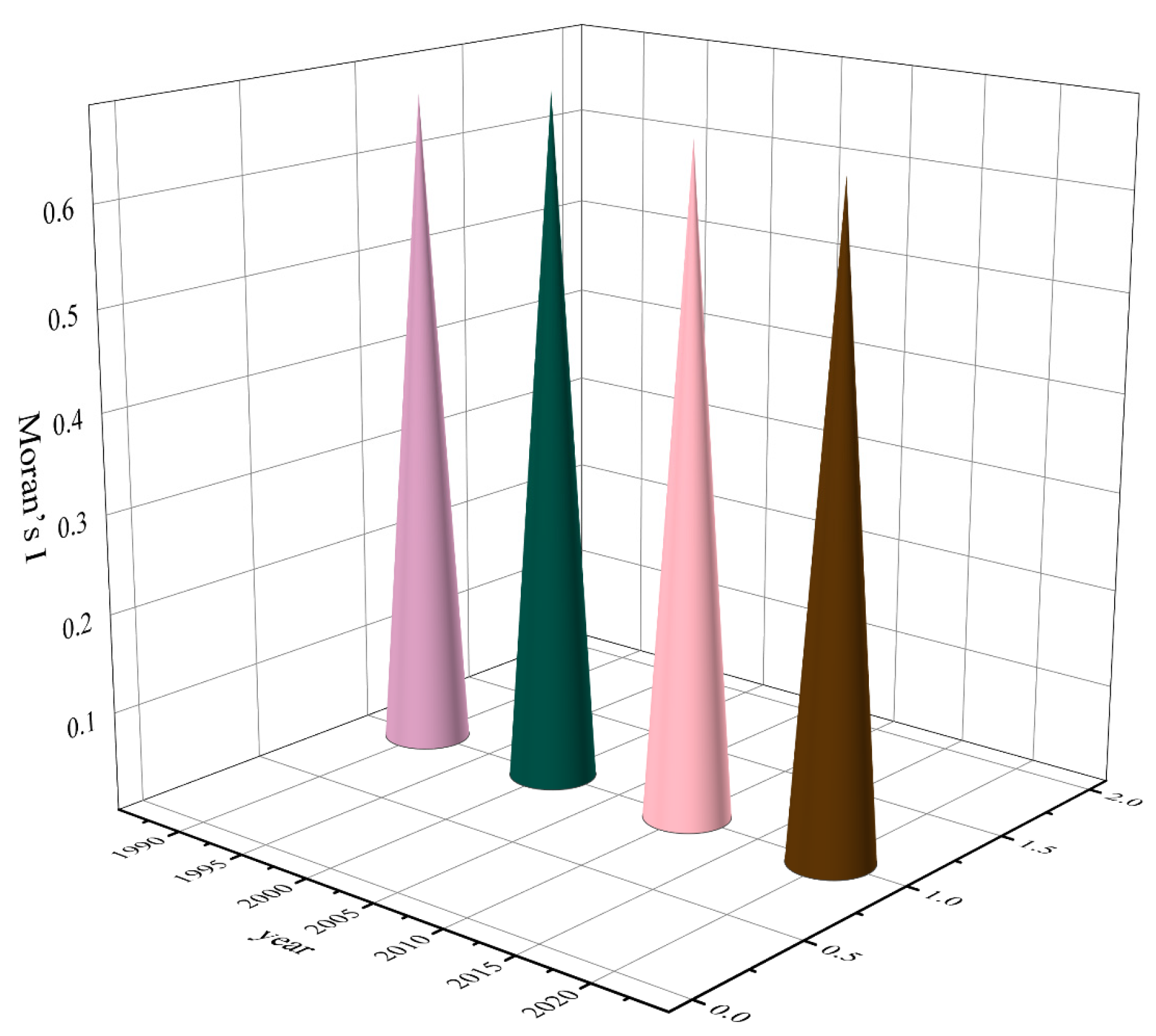
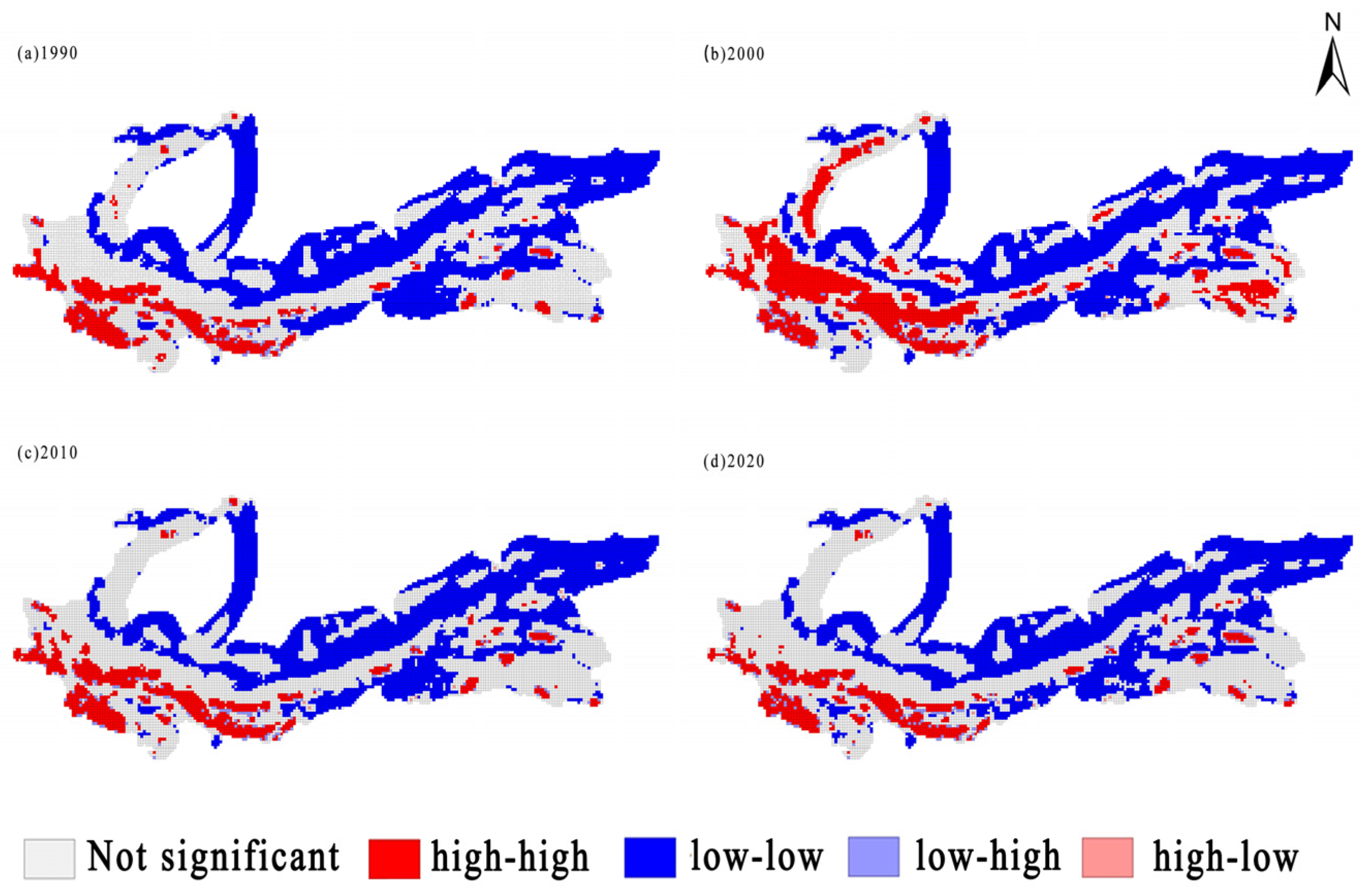
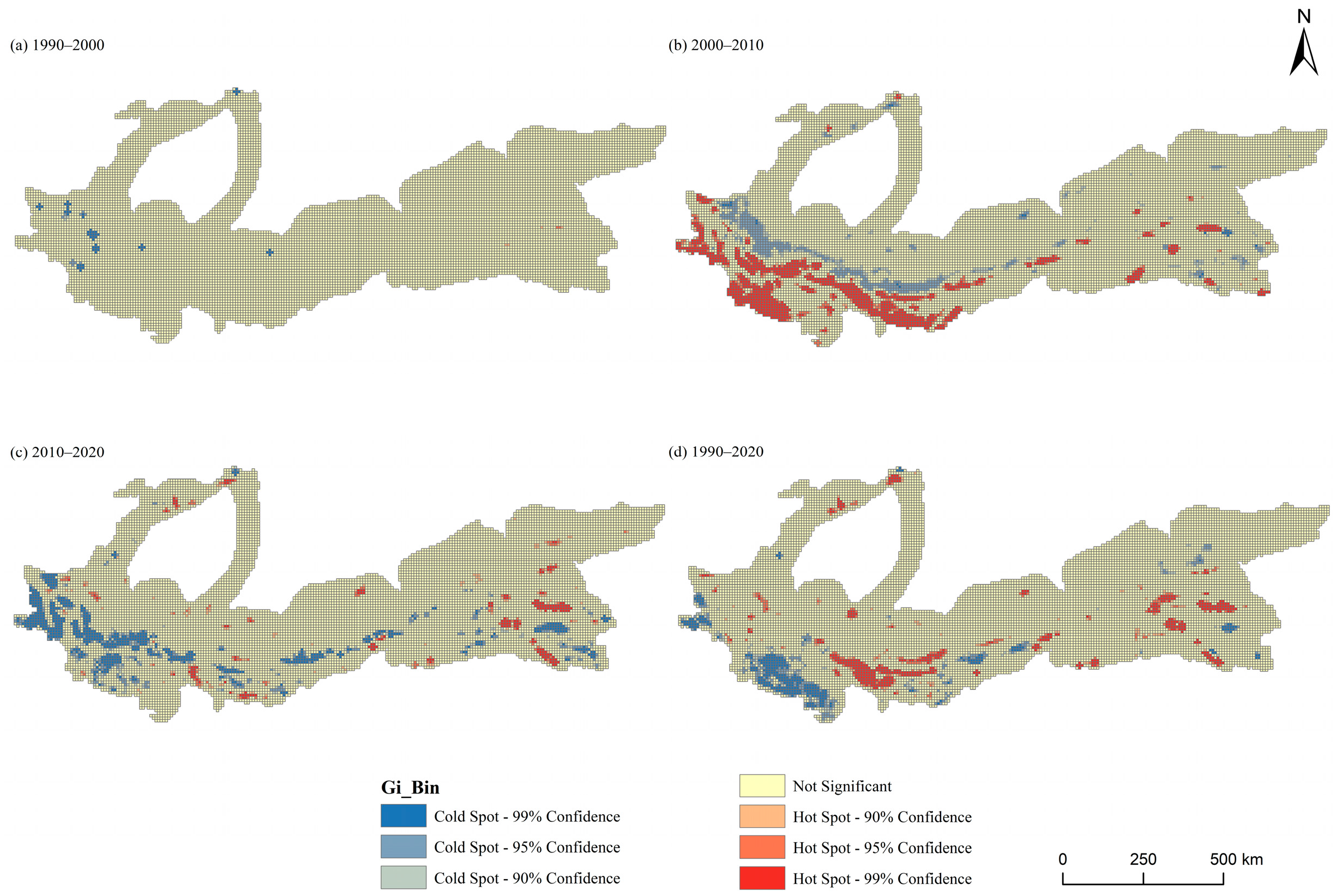

| Serial Number | Land-Use Type | Land Type |
|---|---|---|
| 1 | Cropland | Paddy fields, drylands, mountains, hills, plains, sloping land, etc. |
| 2 | Woodland | Woodlands, open woodlands, shrublands, and other woodlands, etc. |
| 3 | Grassland | High-coverage grassland, medium-coverage grassland, low-coverage grassland, etc. |
| 4 | Water | Rivers and canals, lakes, reservoirs, wetlands, ponds, etc. |
| 5 | Construction land | Urban land, rural settlements, etc. |
| 6 | Barren land | Sandy land, Gobi, saline land, etc. |
| Ecosystem Service Function | Land-Use Type | |||||
|---|---|---|---|---|---|---|
| Cropland | Woodland | Grassland | Water | Construction Land | Barren Land | |
| Gas regulation | 940.91 | 6586.37 | 1505.46 | 0 | 0 | 0 |
| Climate regulation | 1674.82 | 5080.92 | 1693.64 | 865.64 | 0 | 0 |
| Water conservation | 1129.09 | 6021.83 | 1505.46 | 38,351.50 | 0 | 56.45 |
| Soil formation and protection | 2747.46 | 7339.10 | 3669.55 | 18.82 | 0 | 37.64 |
| Waste disposal | 3086.19 | 2465.18 | 2465.18 | 34,211.50 | 0 | 18.82 |
| Biodiversity conservation | 1336.09 | 6134.74 | 2051.18 | 4685.73 | 0 | 639.82 |
| Food production | 1881.82 | 188.18 | 564.55 | 188.18 | 0 | 18.82 |
| Raw material production | 188.18 | 4892.73 | 94.09 | 18.82 | 0 | 0 |
| Entertainment culture | 18.82 | 2408.73 | 75.27 | 8167.10 | 82.60 | 18.82 |
| Total | 13,003.38 | 41,117.78 | 13,624.38 | 86,507.29 | 82.60 | 790.36 |
| Land-Use Type | Cropland | Woodland | Grassland | Water | Construction Land | Barren Land | Total | Transfer |
|---|---|---|---|---|---|---|---|---|
| Cropland | 769.44 | 0 | 119.95 | 1.36 | 2.64 | 2.11 | 895.50 | 126.06 |
| Woodland | 0 | 4.33 | 0.75 | 0.02 | 0.38 | 0 | 5.48 | 1.15 |
| Grassland | 385.81 | 12.70 | 6251.13 | 60.32 | 1594.49 | 10.15 | 8314.59 | 2063.46 |
| Water | 4.04 | 0.07 | 25.07 | 1748.17 | 241.77 | 0.36 | 2019.48 | 271.31 |
| Construction land | 100.80 | 0.36 | 1929.37 | 364.82 | 29,672.65 | 2.64 | 32,070.65 | 2398.00 |
| Barren land | 0.10 | 0 | 0.54 | 0.05 | 0.14 | 1.65 | 2.48 | 0.83 |
| Total | 1260.19 | 17.46 | 8326.82 | 2174.74 | 31,512.07 | 16.91 | ||
| Transfer in | 490.75 | 13.13 | 2075.69 | 426.56 | 1839.42 | 15.26 |
| Land-Use Type | Cropland | Woodland | Grassland | Water | Construction Land | Barren Land | Total | |
|---|---|---|---|---|---|---|---|---|
| 1990 | ESV | 112.43 | 2.12 | 1083.72 | 1644.06 | 0 | 244.11 | 3086.45 |
| Proportion | 3.64% | 0.07% | 35.11% | 53.27% | 0% | 7.91% | 100% | |
| 2000 | ESV | 121.53 | 3.29 | 1047.68 | 1614.50 | 0 | 245.89 | 3032.90 |
| Proportion | 4.01% | 0.11% | 34.54% | 53.23% | 0% | 8.11% | 100% | |
| 2010 | ESV | 145.45 | 4.36 | 1090.76 | 1952.11 | 0.01 | 238.78 | 3431.47 |
| Proportion | 4.24% | 0.13% | 31.79% | 56.89% | 0% | 6.96% | 100% | |
| 2020 | ESV | 158.47 | 6.72 | 1085.42 | 1775.06 | 0.01 | 239.81 | 3265.50 |
| Proportion | 4.85% | 0.21% | 33.24% | 54.36% | 0% | 7.34% | 100% | |
| ESV changes from 1990 to 2020 | 46.04 | 4.59 | 1.70 | 131.00 | 0.01 | −4.29 | 179.06 | |
| ESV change rate from 1990 to 2020 | 40.95% | 216.28% | 0.16% | 7.97% | 587.41% | −1.76% | 5.80% | |
| Type 1 | Type 2 | 1990 | 2000 | 2010 | 2020 | ||||
|---|---|---|---|---|---|---|---|---|---|
| Regulation services | Gas regulation | 128.22 | 4.15% | 125.09 | 4.12% | 121.23 | 3.53% | 132.48 | 4.06% |
| Climate regulation | 165.91 | 5.38% | 162.45 | 5.36% | 174.40 | 5.08% | 173.93 | 5.33% | |
| Water conservation | 876.12 | 28.39% | 860.13 | 28.36% | 1016.28 | 29.62% | 938.75 | 28.75% | |
| Waste disposal | 878.90 | 28.48% | 862.96 | 28.45% | 1009.84 | 29.43% | 942.11 | 28.85% | |
| Subtotal | 2049.15 | 66.39% | 2010.62 | 66.29% | 2321.75 | 67.66% | 2187.28 | 66.98% | |
| Support services | Soil formation and protection | 328.00 | 10.63% | 320.51 | 10.57% | 337.09 | 9.82% | 338.83 | 10.38% |
| Biodiversity conservation | 461.69 | 14.96% | 457.21 | 15.07% | 478.85 | 13.95% | 470.98 | 14.42% | |
| Subtotal | 789.69 | 25.59% | 777.72 | 25.64% | 815.93 | 23.78% | 809.81 | 24.80% | |
| Provision of services | Food production | 70.58 | 2.29% | 70.38 | 2.32% | 76.20 | 2.22% | 77.51 | 2.37% |
| Raw material production | 9.72 | 0.31% | 9.74 | 0.32% | 10.58 | 0.31% | 10.97 | 0.34% | |
| Subtotal | 80.30 | 2.60% | 80.12 | 2.64% | 86.78 | 2.53% | 88.49 | 20.50% | |
| Cultural services | Entertainment culture | 167.30 | 5.42% | 164.44 | 5.42% | 196.48 | 5.73% | 179.93 | 5.51% |
| Total | 3086.45 | 3032.90 | 3420.95 | 3265.50 | |||||
| Land-Use Type | Cropland | Woodland | Grassland | Water | Construction Land | Barren Land | Total | Transfer |
|---|---|---|---|---|---|---|---|---|
| Cropland | 896.58 | 52.77 | 182.78 | 18.26 | 37.82 | 71.91 | 1260.12 | 363.54 |
| Woodland | 0 | 2.44 | 13.20 | 0.06 | 0 | 1.55 | 17.25 | 14.81 |
| Grassland | 256.98 | 195.72 | 6177.14 | 110.21 | 21.11 | 1566.64 | 8327.82 | 2150.67 |
| Water | 0.71 | 0.23 | 65.52 | 1548.90 | 0.01 | 560.27 | 2175.68 | 626.74 |
| Construction land | 2.27 | 2.98 | 6.89 | 1.36 | 3.10 | 0.19 | 16.79 | 13.68 |
| Barren land | 31.99 | 65.21 | 6417.17 | 515.09 | 1.53 | 24,481.08 | 31,512.13 | 7030.99 |
| Total | 1188.53 | 319.34 | 12,862.71 | 2193.88 | 60.66 | 26,684.56 | ||
| Transfer in | 291.95 | 316.90 | 6685.57 | 644.97 | 60.47 | 2200.57 |
| Type 1 | Type 2 | Land-Use Type | ||||||
|---|---|---|---|---|---|---|---|---|
| Cropland | Woodland | Grassland | Water | Construction Land | Barren Land | Total | ||
| Regulation services | Gas regulation | 12.65 | 24.05 | 214.74 | 0 | 0 | 0 | 251.44 |
| Climate regulation | 22.52 | 18.56 | 241.58 | 20.54 | 0 | 0 | 303.19 | |
| Water conservation | 15.18 | 21.99 | 214.74 | 909.81 | 0 | 16.74 | 1178.46 | |
| Waste disposal | 41.49 | 9.00 | 351.63 | 811.60 | 0 | 5.58 | 1219.30 | |
| Subtotal | 91.84 | 73.61 | 1022.68 | 1741.94 | 0 | 22.32 | 2952.38 | |
| Support services | Soil formation and protection | 36.94 | 26.80 | 523.42 | 0.45 | 0 | 11.16 | 598.77 |
| Biodiversity conservation | 17.96 | 22.40 | 292.58 | 111.16 | 0 | 189.70 | 633.81 | |
| Subtotal | 54.90 | 49.21 | 815.99 | 111.61 | 0 | 200.86 | 1232.57 | |
| Provision of services | Food production | 25.30 | 0.69 | 80.53 | 4.46 | 0 | 5.58 | 116.56 |
| Raw material production | 2.53 | 17.87 | 13.42 | 0.45 | 0 | 0 | 34.27 | |
| Subtotal | 27.83 | 18.56 | 93.95 | 4.91 | 0 | 5.58 | 150.82 | |
| Cultural services | Entertainment culture | 0.25 | 8.80 | 10.74 | 193.75 | 0.06 | 5.58 | 219.17 |
| Total | 174.83 | 150.17 | 1943.35 | 2052.21 | 0.06 | 234.34 | 4554.95 | |
Disclaimer/Publisher’s Note: The statements, opinions and data contained in all publications are solely those of the individual author(s) and contributor(s) and not of MDPI and/or the editor(s). MDPI and/or the editor(s) disclaim responsibility for any injury to people or property resulting from any ideas, methods, instructions or products referred to in the content. |
© 2023 by the authors. Licensee MDPI, Basel, Switzerland. This article is an open access article distributed under the terms and conditions of the Creative Commons Attribution (CC BY) license (https://creativecommons.org/licenses/by/4.0/).
Share and Cite
Zhang, Z.; Wang, Y.; Tang, H.; Zhu, Z. Analysis and Prediction of Spatial and Temporal Evolution of Ecosystem Service Value on the Northern Slopes of the Kunlun Mountains Based on Land Use. Land 2023, 12, 2123. https://doi.org/10.3390/land12122123
Zhang Z, Wang Y, Tang H, Zhu Z. Analysis and Prediction of Spatial and Temporal Evolution of Ecosystem Service Value on the Northern Slopes of the Kunlun Mountains Based on Land Use. Land. 2023; 12(12):2123. https://doi.org/10.3390/land12122123
Chicago/Turabian StyleZhang, Zhichao, Yang Wang, Haisheng Tang, and Zhen Zhu. 2023. "Analysis and Prediction of Spatial and Temporal Evolution of Ecosystem Service Value on the Northern Slopes of the Kunlun Mountains Based on Land Use" Land 12, no. 12: 2123. https://doi.org/10.3390/land12122123




